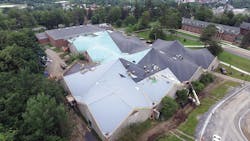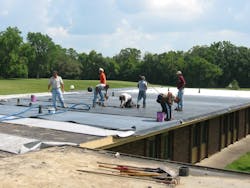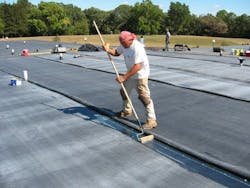The average school building in the United States is expected to last about 60 years, sheltering at least two generations of students that pass through its doors. Structures built from brick, stone, high-quality masonry and other durable materials, maintained with appropriate repairs and upgrades, can last even longer. Buildings on university campuses frequently last even longer with proper care and updates, and perhaps because of historical value.
Given the longevity of these structures, simple math tells us that the roof of an average educational building will most likely need to be replaced, or at least significantly repaired, while the building is in use. Depending on the roof material used in the original structure and the location of the school, it could be more often than that. Heavy snow, intense sunlight, temperature fluctuations, and exposure to high levels of UV radiation can take years off the service life of a roof.
When choosing what kinds of roofs are in their building portfolios, education facility managers should have these key considerations in mind: roof durability, smart scheduling, accurate assessments, and prioritizing sustainability. Roofs shouldn't be an afterthought, nor should the same roofing type be used on every building; roofs are vital to protecting both the building and the environment.
School's out, work starts
For those on the front lines—or more accurately, up on the roof—working on educational structures can present special challenges. Among them, facility managers must deal with a shortened construction season that demands precise scheduling.
Jeff Simcox, director of operations for the Wilson School District in Berks County, Pennsylvania, says that because of the requirements of the school calendar, "all my construction projects typically start the day after graduation." This means stop-gap repairs until school gets out.
"The roof protects everything you've invested in below,” he says. “When you build, you build from the bottom up with a strong foundation. When you repair, you repair from the top down because you have to protect your assets."
Jason Wilen, a forensic architect with the Klein & Hoffman firm, works regularly with a large university covering three campuses. Wilen faces the same issues as Simcox, but with different timing and on a larger scale.
When planning for roof replacement for a university client, Wilen says, the best option often is to schedule the work between terms, when most students are away from campus. This is generally achievable for smaller roofs or roof areas in non-emergencies. (An emergency such as a blow-off or a leak in a critical space like a server room would require immediate action).
When faced with the need to repair or replace larger roof areas, Wilen and his colleagues plan projects in phases. If a roof area is too large or complex for the work to be limited to off-term timeframes, his team favors a design that limits noise, vibrations, odors and the like. Even when adopting this approach, there often are times on university projects when work must stop temporarily. For example, contractors may be required to be off campus when students take exams or during graduation activities. Wilen recommends that early in the design or repair process, contractors should work with a university to determine when disruptions would be most problematic.
"It can take time for the university facility managers to work with the various academic staff to determine those timeframes ahead of time so that schedule restrictions are known early enough to be part of bidding and contractor selection," Wilen says.
Beyond issues presented by the academic calendar, conflicts can occur between the aesthetics and function of a roof. Plans to modify a roof system design to accommodate phasing or limit potentially undesirable attributes can conflict with university design guidelines, and in most cases, the guidelines win.
The best result is when a balance is achieved—following guidelines while working with roofing product manufacturers to optimize the performance of roof systems by using compliant products and methods.
What's under that roof?
Large or small, university campus or rural elementary school, the beginning point of any roof upgrade is to determine what is under the existing roof.
"The first thing I do," Simcox says, "is core-drill to find out what insulation I have underneath, because earlier documents are not always accurate."
Once Simcox knows what type of insulation was used when the roof was installed, he can calculate an R-value "and see if it's adequate and if it meets current code constraints."
Minimum requirements based on a manufacturer's warranty and jurisdictional building codes have likely changed since existing roofs were installed. Simcox says it makes no sense to work with old information when installing a new roof. As a final step in the preparation, he seeks competitive bids from preferred contractors. "I don't want four guys in a pick-up truck showing up and doing the work on a 25,000-square-foot EPDM roof."
Sustainability
Energy codes have evolved in the past two decades, driven by a desire to reduce the greenhouse gases contributing to climate change. Roofing decisions that were relatively straightforward 20 years ago now must consider a broad range of options and implications to achieve sustainability. In some instances, well-meaning local mandates have reduced the flexibility of an architect or building owner to select a product or design that may be more holistically sustainable.
Sustainability is the watchword of the day. Although several environmental issues fall under the umbrella of sustainability, choosing a roofing membrane is one of the most important. A sustainable roofing membrane should be long-lasting and installed according to the manufacturer's requirements to prevent frequent replacement and contributions to landfills. Likewise, energy codes are becoming more stringent so that buildings operate more efficiently and reduce energy use while delivering the same performance. Designers are faced with multiple decisions when installing a new roof or upgrading an existing roof: white, gray, or black membrane? Mounted solar panels? Green roofs and a rooftop garden? Stormwater management? Low carbon materials?
Given the broad range of research available that promises one-size-fits-all recommendations, it may still be difficult to devise the right equation for any one building. The Coalition for Sustainable Roofing, formed by companies representing a wide range of roofing products, offers guidance on holistic roof system design and sustainable roofing assemblies.
Studies by the EPDM Roofing Association (ERA) have tried to measure the impact of roof color on Urban Heat Island (UHI) mitigation and energy efficiency. One study showed that complex and inconsistent temperature assessment protocols are being used in virtually all UHI evaluations, making comparisons of the efficacy of roof color problematic.
A second study looked at the impact of roof albedo and insulation on the energy efficiency of a building. In most cases, it is the insulation, not the color of the roof, that provides the greatest energy benefits. This makes it even more important to find out what is under an existing roof before work begins. A related study by the Polyiso Manufacturers Association reinforces the findings of the ERA research; it found that upgrading building envelope insulation leads to substantial energy savings and carbon emission reductions.
Educational facility planners and managers must be aware of many considerations when it comes to roofs. The out-of-sight, out-of-mind roof may have been an afterthought for facilities managers and architects in the past as they focused on the other issues. But the need for longevity and sustainability in the choice of building materials has changed the roofing equation: The roofs used on educational buildings may finally be getting their due as critical design elements, protectors of the resources in the building below, and the quality of the environment beyond.
Ellen Thorp is managing director of the Coalition for Sustainable Roofing (www.cosur.org).
About the Author
Ellen Thorp
Ellen Thorp is managing director of the Coalition for Sustainable Roofing (COSUR) www.cosur.org.


